|
|
| Разместил (Author): |
SergUA6  |
| Авторские права |
© http://www.radioscanner.ru |
|
|
Текст
|
*** Previouse part ***
Example. SkyOFDM.
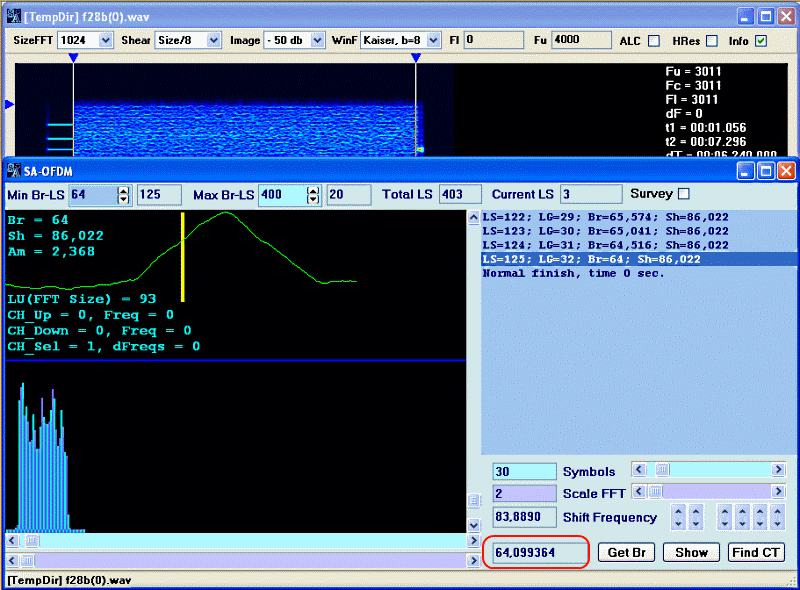
The coefficient k for this signal is equal 0.34375 or 11/32. Current sampling rate isn't true. For this coefficient OCG deduces the following correct couples LU and LG.
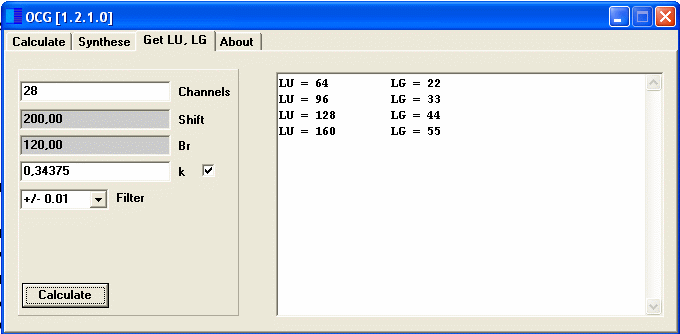
We can select any couple LU and LG. But if to take the first one, then besides oversampling/resampling we will need signal shift on/by frequency downwards also. There is nothing terrible in it, but to leave the signal how it is and to take the second range of parameters LU and LG is easier. Then:
LU = 96, LG = 33, LS = LU+LG = 129 and correct sampling rate for the analysis/demodulation is equal 129*64.099364 = 8268.817956 Hertz. We approximate it to 8269 Hertz.
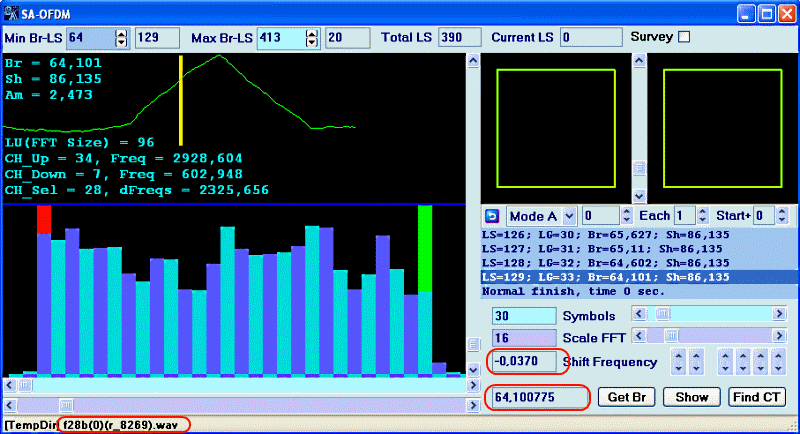
Preliminary symbol-by-symbol review doesn’t show obvious signs of synchro-symbols, however the signal’s ACF and dynamic mapping of constellations, assume presence of the service symbols. It is following from ACF most likely, it is every fifth character.
We are checking it up.
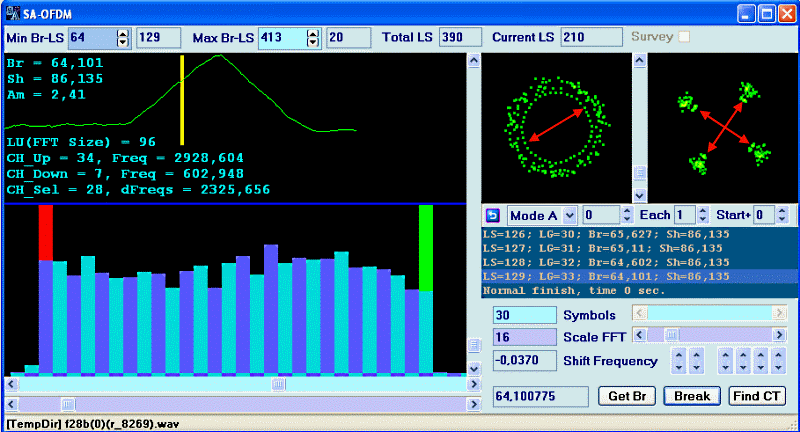
Really every fifth symbol is the synchro-symbol. Clear enough desire to synchronize the point on an absolute plane, through signal shift on/by frequency, as in the relative angles this point is very close from a zero vector.
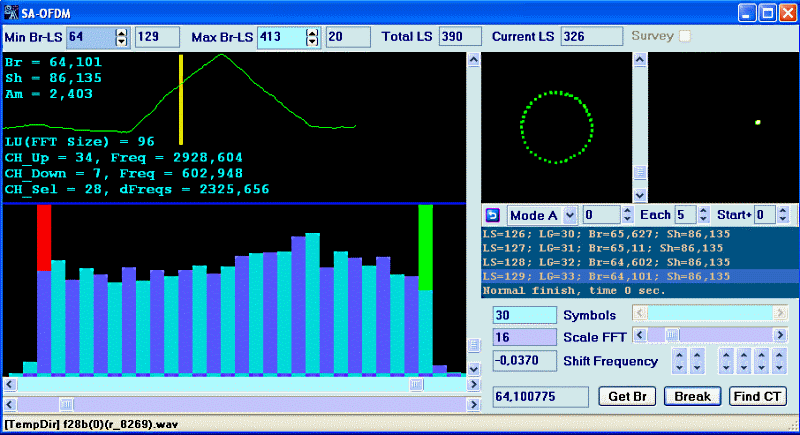
We are doing it and we are looking at the whole constellation in the channel. From the previous picture, the manipulation mode in the channel either PSK-4, or pi/4 dqpsk.
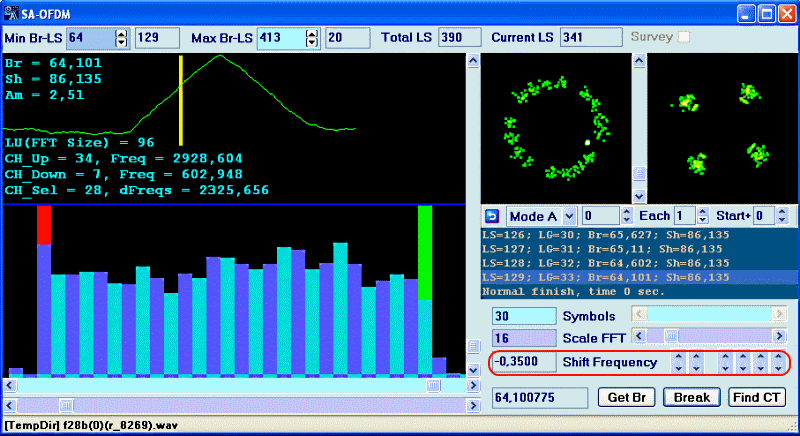
The constellation is strange enough. Also strange that the synchro-symbol’s point has been situated in a zero position in the relative angles, thus it is logical to expect, that there will be the junction/node of the whole constellation in a zero position on this plane, but it not so.
There is a sense to return all in an initial state, and to look for other criterion of shift of the signal by frequency, with the purpose to stop the point at synchro-symbol.
It is possible to return back by two methods:
1 - once again to call function "Get Br"
2 - or to install initial shift equal-0.0370 Hz manually, as it was initially.
After returning into initial state, it is necessary to walk by the virtual shift of the signal in search of the most possible close position of the point in the relative angles to the zero position. There are two such positions: it is the virtual shift on 7 channels downwards (-7), and the virtual shift on 25 channels upwards.
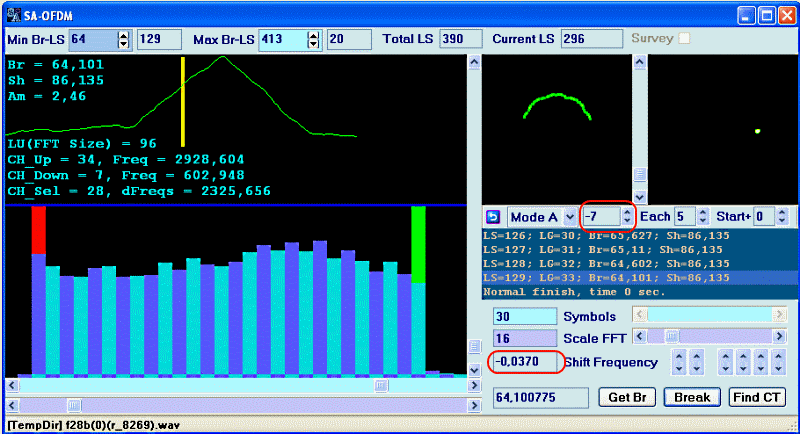
Now we stop the point’s rotation in absolute angles and we look whole constellation.

It is much more similar to the truth, and the manipulation mode in the channels is PSK-4.
The most interesting that even if somehow correct LU and LG has been gotten, then it is unlikely to obtain normal constellations without function of the virtual shift of the signal.
Physical shift on -7 channels downwards, moves the first channel of this signal to the zero position - to the place of a constant component. It isn't normal, that is physically impossible, but having made such action almost nothing good remains from the signal.
For the two first combinations of correct LU and LG, physical shift on 25 channels upwards is impossible, as the whole signal is behind limits of the general band of formation.
Only thanks to function of the virtual shift of the signal by frequency, we can easily place/locate the signal in any "virtual" position on a working grid of channels without any restrictions.
The third set of values LU and LG supposes sampling rate suitable for the analysis/demodulation equal 11025 Hertz, for the current/measured speed of manipulation in 64.1 Hertzs. And only in this case physical relocation of the signal in a position of 25th channel without distortions is possible, but hardly anyone will consider it as something right the signal’s shift on 2 Khz upwards.
It is not eliminated that it is a firm feature of developers. Without knowing this feature of the signal SkyOFDM, to develop the exterior/off-set demodulator will be very difficult the problems are guaranteed.
***
Some words in conclusion.
The first one.
It is not difficult to notice, that exactly coefficient k figures in all considered examples as the key moment. We are meaningly doing it. Why? After all k is calculated either as LG/LU or as ((Sh/Br) - 1), that is actually necessary parameters of formation OFDM are known to us. It is not possible to get k by different methods. So why k?
Everything is correct.
But there is one moment. From the concrete signal we can get only unique LU and LG, or Sh and Br. But as it has been shown above, it doesn't mean at all that other correct LU and LG don't exist.
The coefficient k is much more general-purpose universal value. This coefficient allows to look at specific implementation OFDM from much wider point of view. The coefficient k gives more information about a specific signal more than unique pair of values LU and LG. That’s why we name its universal/fundamental/magic constant of any OFDM signal with CP, and for this reason we put it as the primary goal/key of the analysis of OFDM signals with CP.
The second.
In all examples above, the coefficient k is already known, and there may appear the impression that signals with not unknown parameters but with very well-known parameters has been analyzed. It is not so. Really, we have insider decisions for obtaining k, but these decisions are far from the optimal.
Even the well-known signal WinDrm, we initially consider as absolutely unknown. Simply the function of obtaining k parameter is inaccessible to a wide range of users. We are looking for more optimal variants of solutions of this task, and sooner or later they will be found, it is a matter of time, and, I hope not such far.
The third.
It is not necessary to perceive the article too rectilinearly. If we are writing that at symbol-by-symbol review of the signal WinDrm in extreme channels some specific is observed doesn't mean that this is only the one thing that is possible to find out . As it doesn't mean that we don't see/not have found out anything else, it is just isn't possible within the limits of overview articles, to describe each nuance and each feature.
If we are writing that from ACF of the signal it follows that every fifth symbol is service/special it means, we assume that the user can to check it up independently. Especially it is basic elements of the analysis.
The main objective of this article is to show application field of new possibilities implemented in SA. To describe the general approach to analysis of OFDM signals with CP. I hope, though in some measure we realized it. :)
Good Luck ~
|
|
|
|
Добавлять комментарии могут только зарегистрированные, активировавшие регистрацию и не ограниченные в доступе участники сайта!
|
| Файл создан: 23 Mar 2011 22:38, посл. исправление: 23 Mar 2011 22:53 |
|

